Peru
Birds of Peru
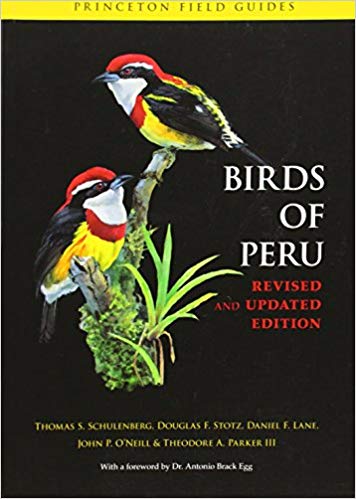
Princeton Guide by Thomas Schulenberg, Douglas Stotz, Daniel Lane, John O’Neil & Theodore Parker 2010.
The Princeton University Press and Helm Guides publish identical guidebooks for birds of many countries worldwide. Books published in the USA are published by Princeton. Those published in other countries are published by Helm.
It describes every one of Peru’s 1,817 species.
Be sure to get the updated version, which contains 25 more pages than the first edition.
Birdtripper members get 30% off Princeton books. Click members to register.
(M) Write a review
You must be logged in to submit a review. Go to Members page to Log-in or Register
Birds of Machu Picchu
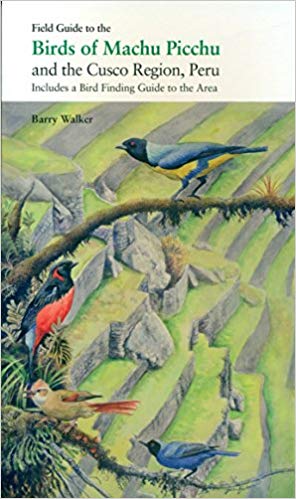
Birds of Machu Picchu & Cusco by Barry Walker 2015.
It covers 500 species of the region and offers suggestions for good birding locations. If you are going to Machu Picchu, this would be an excellent book to have. The price for this book ranges from $50 to $75. Birdtripper has not seen this book, so I’m unsure why it is so expensive. If you have a copy of this book, please write a review.
(M) Write a review
You must be logged in to submit a review. Go to Members page to Log-in or Register
Chile
Birds of Chile
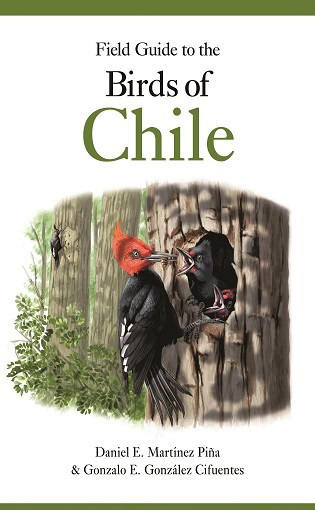
Princeton Field Guide to the Birds of Chile by Daniel E Martinez Pina & Gonzalo E. Cifuentes 2021
It’s an excellent book for the birds of Chile. Note that Helm Guides also publishes the exact same book.
The book is small, with 224 pages, so it is easy to carry in the field. It has the standard layout with drawings on the right and text and maps on the left. The illustrations are of excellent quality, with several for each species.
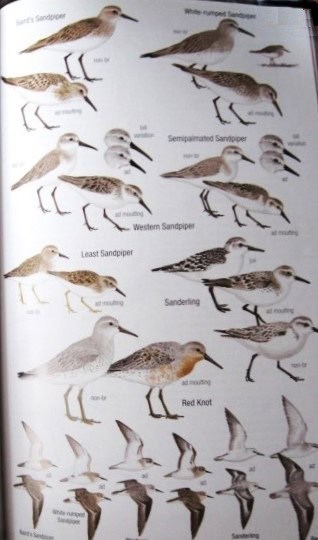
Each species has several excellent drawings, some perched and some flying.
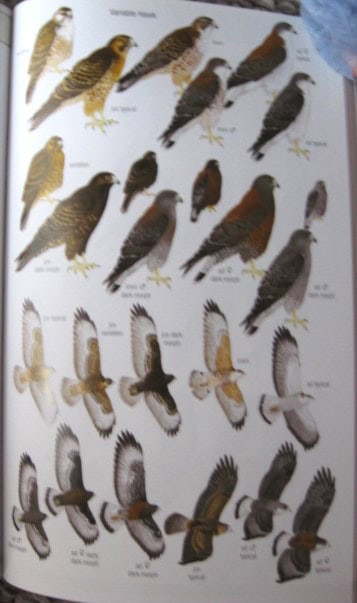
For the Variable Hawk, there are 28 draw2ings. As its name implies, this species of hawk can appear in many different colours and patterns. I have not seen any field guide that provides so much detail for a single species.
Chile Habitat
Chile is the longest country in the world, being 4,270 km from north to south but only 356 km wide at its widest point and only 64 km wide at its narrowest point. The habitat ranges from desert in the north to rainforest in the south, making for a long and skinny map with many different habitats. The problem with a country of this shape is that visiting all the various habitats in a single trip would be challenging unless you have a lot of time. For example, more bird species exist in the rainforest than in the northern deserts.
Maps
Some of the maps in the book show the entire country, and some show only the part that the particular species inhabits. A map showing all of South America replaces the map of Chile for some species when appropriate, notable for seabirds and sandpipers.
The maps are colour-coded to show the year-round range if there is one. Or separate breeding and non-breeding ranges. This is an excellent feature, as most guidebooks show only the total ranges, usually divided by summer and winter migration, instead of breeding or non-breeding ranges, which are not necessarily the same thing.
Text and Taxonomic Range
No specific taxonomic authority is followed. Rather, it seems to combine taxonomic orders with the author’s criteria. The book describes 468 species, including birds seen in Chile at least five times. Some books include species that may have been seen only once in their country, twenty years ago, which is misleading.
The text for each bird included notes on habitat, voice, and where to find them. There is no information about similar species to each bird. A letter indicates if the bird is a resident, migrant or vagrant for each species.
The text also includes a small section on “Where to See” for each species, which is really helpful. Most books do not have this advice.
The Index
The index includes English and Scientific names divided by a bold alphabet letter. This simple thing speeds up searching the index, but only some books bother with it. I write in the letter myself for books that do not have this feature. There is also an index by family inside the back cover, which is very useful.
Additional Features

For some families, there is a lot of additional information. For example, for Albatrosses, there are three extra pages. One page shows Albratrooss heads with three or four drawings of each species to compare with other species and also to compare with different stages of life.
Another page shows the entire Albatrosses body instead of only the head, with two to four drawings of each species. All this is in addition to several drawings of albatross in the usual locations with the maps and text.
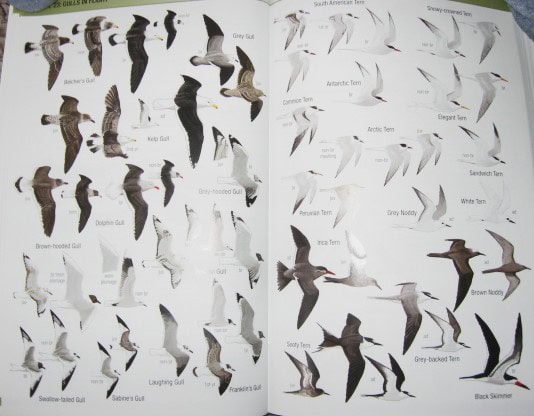
There are two extra pages of gulls and terns in light, in addition to the usual species photos.
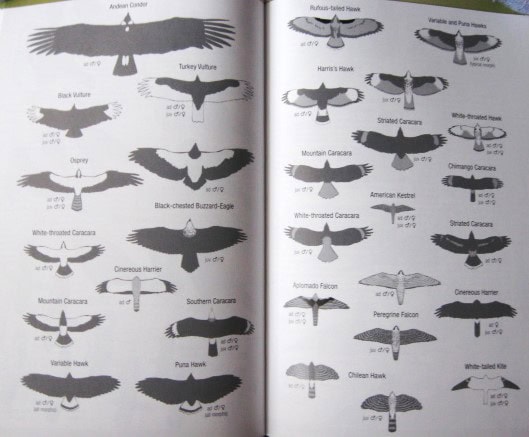
For raptors, there are two pages of black and white drawings showing silhouettes to help you identify them when observing them from below.
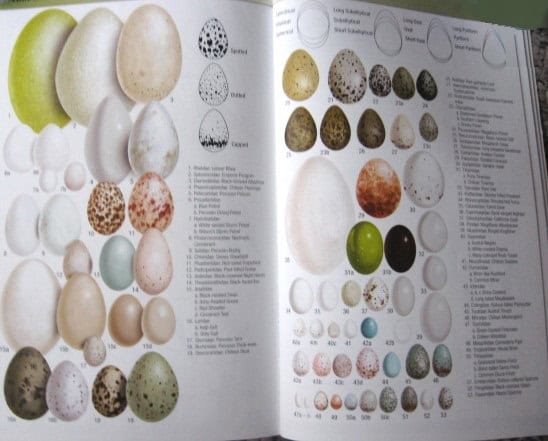
There are even two pages showing the eggs of 81 species.
At the top of each page is a colour bar showing the family name
Four pages are devoted to rare vagrants. There is an appendix listing the endemic birds of Chile, each with a conservation status. Finally, there is a checklist of all the birds of Chile where you can check off the ones you have seen if you wish.
The print quality is excellent, with the images on semi-gloss paper, and this is a stiff stain-and-water-resistant cover.
Conclusion
Overall, this is one of the best field guidebooks. It is packed with drawings and information and yet is light enough to carry in the field in your pack. I wish all guides were of this quality. I highly recommend this book if you are going birding in Chile.
(M) Write a review
Birdtripper members get 30% off Princeton books. Click members to register.
You must be logged in to submit a review. Go to Members page to Log-in or Register
Ecuador
Birds of Ecuador

Helm Guide – Birds of Ecuador by Juan Freile and Robin Restall. 2018
This book is a bit too big to be a field guide. Three centimetres thick and weighing 1.14 kg makes it the biggest field guide in my collection. Unfortunately, this is necessary to accommodate the 1,630 species in Ecuador.
It has the standard field guide layout with drawings on the right and a map and text on the left.
The maps are small, as there are six species per page. This could not be improved without making the book even thicker. The maps are adequate and show the range of residents, migrants,
The Text
- The text gives information about the habitat.
- A very brief description (more is unnecessary as you have the drawing).
- Information about the bird’s lifestyle, such as whether it is found on the ground or in the treetops and whether it travels solo, in pairs, or in flocks.
- It also describes the calls.
- Finally, there is information about similar species and whether the bird is rare or common in Ecuador, but it does not give its official conservation status.
The book follows the South American Classification Committee’s taxonomic order.
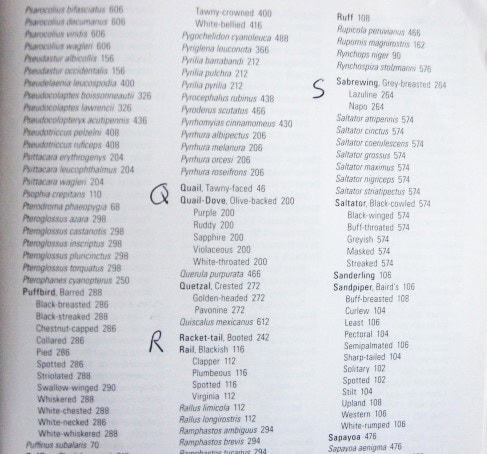
A checklist of all species found in Ecuador is at the back and an index. Unfortunately, the index is all run together with just a tiny half-line space between letters of the alphabet. This is the only fault I could find with this otherwise excellent publication. I rectified this by printing a large letter at the start of the species for the following letter of the alphabet.
Conclusion
Overall, this is an excellent guide, although it is a bit too big and heavy to carry in the field, being almost double the size of other field guides.
(M) Write a review
You must be logged in to submit a review. Go to Members page to Log-in or Register
Galapagos
For Guidebooks for the Galapagos Islands click here. (Members only)